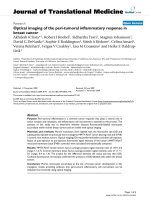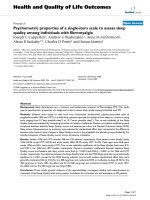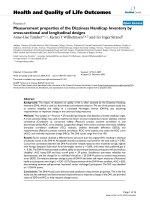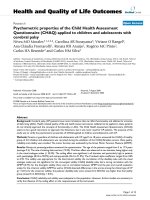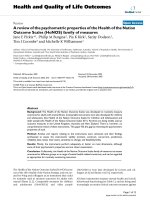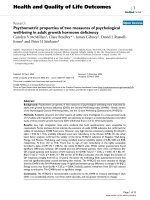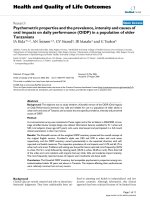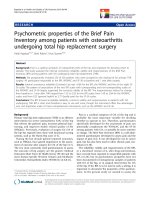Báo cáo hóa học: " Optical properties of exfoliated MoS2 coaxial nanotubes - analogues of graphene" pdf
Bạn đang xem bản rút gọn của tài liệu. Xem và tải ngay bản đầy đủ của tài liệu tại đây (2.94 MB, 6 trang )
NANO EXPRESS Open Access
Optical properties of exfoliated MoS
2
coaxial
nanotubes - analogues of graphene
Bojana Visic
1*
, Robert Dominko
2†
, Marta Klanjsek Gunde
2†
, Nina Hauptman
2†
, Sreco D Skapin
1†
and
Maja Remskar
1,3
Abstract
We report on the first exfoliation of MoS
2
coaxial nanotubes. The single-layer flakes, as the result of exfoliation ,
represent the transition metal dichalcogenides’ analogue of graphene. They show a very low degree of restacking
in comparison with exfoliation of MoS
2
plate-like crystals. MoS
2
monolayers were investigated by means of electron
and atomic force microscopies, showing their structure, and ultraviolet-visible spectrometry, revealing quantum
confinement as the consequence of the nanoscale size in the z-direction.
Keywords: molybdenum disulfide, nanotubes, exfoliation
Background
In recent ye ars, significant progress has been made in
exfoliating graphene directly from graphite, which is sup-
posed to produce samples with fewer defects [1]. Exfolia-
tion of the metallic-layered compounds TaS
2
[2,3] and
NbS
2
[3] is kno wn for more than 30 years. Also, prepara-
tion of a single molecular layer of MoS
2
out of the crystal-
line 2H-MoS
2
by intercalation of lithium has been
reported in 1986 [4], which was the first exfoliation of a
layered semiconductor, and it was followed by the exfolia-
tion of WS
2
[5]. Exfoliation via other solvents [6] and
cleaving processes [7] has been reported recently. Until
now, there have been no reports on the attempt to exfoli-
ate transition-metal disulphide nanotubes.
Bulk 2H-MoS
2
is made of S-Mo-S sandwich layers,
where every molybdenum sheet is between two sheets of
sulfu r. It was found that crystalline MoS
2
has three poly-
types: 1T, 2H, and 3R, where the integer indicates the
number of layers per unit cell and T, H, and R indicate the
trigonal, hexagonal, and rhombohedral primitive unit cells,
respectively. Whereas the interactions within the sandwich
correspond to the chemical bonds, the neighboring layers
are weakly connected with Van der Waals bonds, and for-
eign materials can be inserted into the Van der Waals gap,
and under appropriate conditions, the layers can be
further separated to form single molecular layers.
Single molecular layers of MoS
2
in a water suspension
have been prepared by intercalation of lithium into crystal
2H-MoS
2
followed by exfoliation in water. As this aqueous
suspension is aging, restacked MoS
2
with two monolayers
of water is formed (the wat er-bilayer phase), with water
monolayers between parallel, but rotationally disordered
MoS
2
layers. For this structure, a 2a
0
× a
0
pattern was
confirmed [8], where a
0
is the lattice constant of bulk 2H-
MoS
2
. Single layer shows a change in lattice symmetry
from 2H to 1T, and it is suggested that the change in
coordination is electronically driven by Li electron dona-
tion to the MoS
2
host [9]; t his configuration is preferred
bec ause the electrons d onated to the valence band in 1T
configuration occupy a much lower level than the elec-
trons donated to the conduction band of the 2H structure.
It was shown that this structural transition is followed by a
change in the optical absorption spectrum, where two
strong absorption peaks for 2H-MoS
2
are absent [10]. The
structural transformation is also present in the formation
of single molecular layers of WS
2
. Lattice constants in the
basal (001) plane were found: for 2H-MoS
2
crystal with a
trigonal prism configuration, it is 3.162 Å; for Li-MoS
2
crystal with an octahedral configuration, 3.6 Å; and for
MoS
2
single layer with an octahedral configuration, 3.27 Å
[11].
Exfoliation of MoS
2
can lead to the synthesis of many
new materials, obtained by restacking the single layers
* Correspondence:
† Contributed equally
1
Jozef Stefan Institute, Jamova cesta 39, Ljubljana, 1000, Slovenia
Full list of author information is available at the end of the article
Visic et al. Nanoscale Research Letters 2011, 6:593
/>© 2011 Visic et al; licensee Springer. This is an Open Access a rticle distributed under the terms of the Creative Commons Attribution
License (http://cre ativecommons.org/licenses /by/2.0), which permits unrestricted use, distribution, and reproduction in any medium,
provided the original work is properly cited.
with, for example, organic molecules [12-14]. It was dis-
covered that MoS
2
photoluminescence increases with
decreasing layer thickness, the strongest is on single
layer [15], which holds promise for new nanophotonic
applications, and it was also realized as a field-effect
transistor [16], which can be applied in new areas of
optoelectronics.
MoS
2
is also known as a solid lubricant which has been
used in the industry for the last 60 years. At low-humidity
conditions, it is possible to obtain a low friction coefficient
of 0.05 [17]. Ultra-low friction of 0.003 was reported
between MoS
2
flakes and MoS
2
surfaces [18]. The pro-
blem of edge oxidation and preservation of the flakes in
parallel orientation with the surface with a low degree of
restack ing can be minimized with the reduction of thick-
ness. It is desired to obtain the thinnest flakes possible,
which can be achieved by exfoliating MoS
2
coaxial
nanotubes.
Methods
The MoS
2
coaxial nanotubes (Nanotul Ltd., Ljubljana,
Slovenia) are synthesized by sulfurization transformation
of M
6
S
2
I
8
nanowires under gas flow of H
2
/H
2
Smixture
in an argon atmosphere [19]. They were dried in a dry
box (glove box, < 1 ppm of H
2
O, M.Braun Garching,
Germany) for at least 6 h in vacuum at 120°C, then sus-
pended in a solution of 2.5 M butyllithium in hexanes
(0.69 3 g/mL, Sigma-Aldr ich, St. Louis, MO, USA), where
it was left for 3 days. Exfoliation occurs by immersing the
lithium-intercalated compounds in water after taking
them out of the dry box, which provides a water-bilayer
phase of Mo S
2
. To obtain single layers of MoS
2
in water
suspension, the material was washed repea tedly with dis-
tilled water and centrifuged. The reaction that occurs
between the water and intercalated lithium results in
hydrogen gas release and lithium hydroxide formation.
The washing process red uces lithiu m concentrati on
(from a pH of 12 to 7). Consequently, the water-bilayer
phase, which is stable in a higher pH [5], splits into single
MoS
2
layers.
The exfoliated material was characterized by scanning
electron microscopy [SEM], transmission electron micro-
scopy [TEM], atomic probe techniques (atomic force
microscopy [AFM] and STM), and X-ray diffraction
[XRD]. The XRD spectra were recorded with an AXS D4
Endeavor diffractometer (Bruker Corporation, Karlsruhe,
Germany), with Cu Ka
1
radiation and a SOL-X energy-
dispersive detecto r with the angular range of 2θ from 5°
to 75° with a step size of 0.04° and a collection time of 3 to
4s.
The process of exfoliation was elucidated by ultraviolet-
visible [UV-Vis] spectroscopy. The spectra were recorded
in a 10-mm-path length quartz cell on an Agilent 8453
UV-Vis Spectrophotometer (Agilent Technologies, Inc.,
Santa Clara, C A, USA) at 23°C ± 1°C in a wavelength
range of 180 to 1,000 nm, with a 1-nm resolution. For
comparison, the PerkinElmer Lambda 950 photospect-
rometer (Waltham, MA, USA) was used under the same
conditions. All UV-Vis measurements were performed on
the material in a water solution.
Results and discussion
The main reason why the nanotubes (Figure 1a) are used
for exfoliation is that they already have gaps between their
coaxial cylinders, as shown in Figure 1b. The nanotubes
keep an outside shape of the Mo
6
S
2
I
8
nanowire precursor,
but the difference in mass density between the wires and
MoS
2
compounds leads to a creation of an empty space
inside the MoS
2
nanotubes that separates the adjacent
cylinders and c reates gaps between them [19], so it is
easier to intercalate them; and the nanotu be walls have a
curvature, which prevents restacking.
The TEM micrographs of exfoliated MoS
2
nanotubes
are shown in Figures 1c, d, while the AFM image and the
correspond ing profile are shown in Figures 1e, f, r espec-
tively. The final product of the exfoliation process contains
mainly of single-layer MoS
2
flakes.
The UV-Vis absorption spectra were measured on exfo-
liated MoS
2
nanotubes, and the comparison was made
with the MoS
2
coaxial nanotubes (used for exfoliation)
and 2H-MoS
2
plate-like powder (< 2 nm, 99% purity,
Sigma-Aldrich, St. Louis, MO, USA). The samples were
prepared in a form of dispersion in water, with concentra-
tions showing comparable intensities of optical absorption.
Both powder and nanotube spectra (Figure 2) show the
features that can be assigned to the A and B excitons,
characteristic for the 2H-polyt ype and cor respond to the
smallest direct transition at the K point of the Brillouin
zone (K
4
® K
5
and K
1
® K
5
transitions, respectively) [20].
The existence of the two excitons is due to the interlayer
interaction and spin-orbit splitting, with the splitting value
of approximately 60 nm (0.17 eV).
For the MoS
2
coaxial nanotubes, peak positions for A
and B excitons are at 702 nm (1.77 eV) and 644 nm (1.92
eV), respectively, with the red shift of the absorption peaks
compared to the powder, where their values are 692 nm
(1.79 eV) and 634 nm (1.96 eV). The red shift is due to
the quantum confinement, as explained by Frey et al. [21].
The excitons are separa ted by 60 nm fo r both materials,
which is in good agreement with the literature [21].
Another broader peak, observed at 540 nm (2.30 eV), can
be assigned to a direct transition between the states deep
in the valence band to the conduction band at the M
point of the Brillouin zone [20]. The strong peak at 210
nm (5.9 eV), being at the edge of the spectrometer’srange,
is usually disregarded from the analysis, for the w ave-
lengths were so small, we get increased scattering, and one
of the consequences is a false peak. Since the energy
Visic et al. Nanoscale Research Letters 2011, 6:593
/>Page 2 of 6
Figure 1 Microscopy. MoS
2
nanotubes before exfoliati on: (a) SEM image of short parts of millimeter-long nanotubes with diameters up to 500
nm; (b) TEM image of the pristine nanotube revealing spontaneous partial splitting of the nanotube’s wall into several blocks, up to 10 nm in
thickness; (c) TEM micrograph of the MoS
2
nanotube during the first stage of the exfoliation process; (d) TEM micrograph of the MoS
2
single
layers as a final stage of nanotube exfoliation; (e) AFM image (contact mode) of the surface corrugation on a thin MoS
2
nanoflake with a (f)
corresponding line profile.
Visic et al. Nanoscale Research Letters 2011, 6:593
/>Page 3 of 6
associated to this peak is too large to be indubitably
assigned to a particular electronic transition, the nature of
the peak is still inconclusive.
ThechangefromLi-MoS
2
to exfoliated MoS
2
was
recorded by UV-Vis absorption during a centrifugation-
washing process (Figure 3). At the beginning, every vial
consists of 0.5 mL of Li-MoS
2
, diluted with 1.5 mL of dis-
tilled water and sonicated for 5 min. The UV-Vis spec-
trum of the initial solution is shown in Figure 3a. Each
vial was centrifuged for 20 min at 10,000 rpm, and the
liquid part was replaced with distilled water in order to
remove the excess lithium. The process has to be
repeated at least five times, during which the pH is
lowered from 12 to 7, and thus, the single layers are
obtained from the removed liquid. The corresponding
spectrum is shown in Figure 3b.
Both the Li-MoS
2
and the exfoliated MoS
2
have peaks
around 200 nm as well as two peaks around 300 and
400 nm (4.11 and 3.11 eV, respectively), as seen in
Figure3.Thereisnoevidenceofexcitonsatapproxi-
mately 700 nm. We suggest that the two peaks asso-
ciated with the exfoliated material are A and B excitons
that exhibit a large blueshift (2.23 and 1.05 eV, respec-
tively) due to the quantum-size confinement. To assert
this claim, the effective mass treatment was applied [22].
This model is used to describe size quantization of the
carriers’ energy spectrum in semiconductors. In terms of
themodel,andinthesizeregimewherequantumcon-
finement effects are prominent, the shift of the absorp-
tion edge or bandgap is inversely proportional to the
effective mass of the excitons:
E
g
≈
(
π
¯
h
)
2
μL
2
z
,
where ΔE
g
istheenergyshift,μ is the excitons’ effec-
tive mass in the direction parallel to the z-axis, and L
z
is
the thickness of the nanoparticles in the z-direction.
For the given exciton masses, μ
A
=1.28m
e
and μ
B
=
4.10 m
e
[23], and energy shift obtained in our experi-
ment, we can estimate the thickness of the sample:
L
A
z
≈ 5
˚
A
and
L
B
z
≈ 4
˚
A
. Both values are in the frame
of accuracy for the MoS
2
monolayer thickness [11].
The aging process of the exfoliated material was
observed,asshowninFigure3c.Themainfeatureis
that the peak at 200 nm becomes more prominent in
time, but the shoulders at 300 and 400 nm remain
Figure 2 UV-Vis spectra of the powder and nanotubes.UV-Vis
absorption spectra of the (a) MoS
2
powder and (b) MoS
2
nanotubes.
Figure 3 Aging. Absorption spectra of MoS
2
during the exfoliati on
process: (a) the initial sample containing Li-MoS
2
;(b) the completely
exfoliated MoS
2
nanotubes; (c) the completely exfoliated MoS
2
nanotubes after 29 days.
Figure 4 XRD of the nanotubes. X-ray spectrum of the MoS
2
coaxial nanotubes.
Visic et al. Nanoscale Research Letters 2011, 6:593
/>Page 4 of 6
unaltered. For the exfoliated bulk material, the evidence
of restacking starts to occur in a few days with the reap-
pearing of A and B excitons at 700 nm [11]. On the
contrary, for the exfoliated nanotubes, this effect was
not observed even after 3 months.
The XRD patterns of the MoS
2
nanotubes, exfoliated
nanotubes in a wet, paste-like form, and dry, restacked
MoS
2
nanolayers are presented in Figures 4 and 5. Fig-
ure 4 shows the XRD spectrum of MoS
2
nanotubes
used for exfoliation, with the peaks indexed in accor-
dance with the hexagonal lattice parameters after Joint
Committee on Powder Diffraction Standards card num-
ber 77-1716. The spectrum of the exfoliated material
was recorded in a wet, paste-like form in order to avoid
drying and restacking. The absence of the (00l) peaks
suggests the majority of single layers in the sample. The
(002) peak is highly asymmetric with a sawtooth shape.
This effect was explained as the indication of the pre-
sence of the superlattice [8]. When the sample is dried,
all of the peaks characteristic for 2H-MoS
2
reappear.
To quantify t he effective size of the particles for the
nanotubes and wet, paste-like MoS
2
, the broadening of
theXRDlinesisconsideredbyapplyingtheDebye-
Scherrer equation:
L =
Kλ
βCosθ
,
where L is the effective particle size, K is the shape
factor, b is the XRD line broadening at half the maxi-
mumintensitygiveninradians,l is the wavelength of
X-rays, and θ is the scattering angle. In order to use the
equation, peaks must be broadened due to crystallite
size, not due to instrument optics, so the peaks that are
not well resolved are not taken into account. The results
are summarized in Table 1.
Conclusion
Exfoliated MoS
2
coaxial nanotubes are produced via
chemical exfoliation, resulting in single-layer flakes that
are stable for months, with a low degree of restacking.
Both X-ray spectra and TEM images confirm that the
material is indeed composed of MoS
2
monolayers. In
addition, UV-Vis spectra show a strong quantum con-
finement effects. The relatively simple process of getting
one-layer-thick MoS
2
can be used to provide new types
of materials with possible applications in polymer com-
posites, photovoltaics, and nanoelectronics.
Acknowledgements
The authors thank Janez Jelenc for the AFM images and Janez Kovac for the
useful discussions.
Author details
1
Jozef Stefan Institute, Jamova cesta 39, Ljubljana, 1000, Slovenia
2
National
Institute of Chemistry, Hajdrihova 19, 1000 Ljubljana, 1000, Slovenia
3
Centre
of Excellence Namaste, Jamova 39, Ljubljana, 1000, Slovenia
Authors’ contributions
BV acquired and interpreted the data, carried out the analysis and Uv-Vis
measurements, and drafted the manuscript. RD helped in the chemical part
by carrying out the lithium intercalation. MKG and NH participated in the
additional UV-Vis measurements. SDS acquired the XRD data. MR has been
involved in revising the manuscript and has given the final approval of the
version to be published. All authors read and approved the final manuscript.
Competing interests
The authors declare that they have no competing interests.
Figure 5 XRD of the exfoliated nanotubes.X-rayspectraof(a)
the exfoliated MoS
2
in a wet, paste-like form and (b) the material
after drying.
Table 1 The calculated effective particle size of the given reflections
Reflection b
(rad)
Effective particle size
(nm)
MoS
2
nanotubes Exfoliated MoS
2
MoS
2
nanotubes Exfoliated MoS
2
(002) 0.01 0.08 15 ± 1 2 ± 1
(100) - 0.02 - 7 ± 1
(103) 0.04 0.07 5 ± 1 3 ± 1
(105) 0.05 0.08 5 ± 1 3 ± 1
(110) 0.01 - 30 ± 1 -
(200) 0.03 - 15 ± 1 -
Visic et al. Nanoscale Research Letters 2011, 6:593
/>Page 5 of 6
Received: 31 August 2011 Accepted: 15 November 2011
Published: 15 November 2011
References
1. Geim AK, Novoselov KS: The rise of graphene. Nat Mater 2007, 6:183.
2. Murphy DW, Hull GW Jr: Monodispersed tantalum disulfide and
adsorption complexes with cations. J Chem Phys 1975, 62:973.
3. Liu C, Singh O, Joensen P, Curzon AE, Frindt RF: X-ray and electron
microscopy studies of single-layer TaS
2
and NbS
2
. Thin Solid Films 1984,
113:165.
4. Joensen P, Morrson SR: Single-layer MoS
2
. Mater Res Bull 1986, 2:457.
5. Yang D, Frindt RF: Li-intercalation and exfoliation of WS
2
. J Phys Chem
Solids 1995, 57:1113.
6. Coleman JN, et al: Two-dimensional nanosheets produced by liquid
exfoliation of layered materials. Science 2011, 331:568.
7. Novoselov KS, Jiang D, Schedin F, Booth TJ, Khotkevich VV, Morosov SV,
Geim AK: Two-dimensional atomic crystals. PNAS 2005, 102:10454.
8. Quin XR, Yang D, Frindt RF, Irwin JC: Real-space imaging of single-layer
MoS2 by scanning tunneling microscopy. Phys Rev B 1990, 44:3490.
9. Dahn JR, Py MA, Haering RR: Entropy measurements on Li
x
TiS
2
. Can J Phys
1983, 61:1093.
10. Joensen P, Crozier ED, Alberding N, Frindt RF: A study of single-layer and
restacked MoS
2
by X-ray diffraction and X-ray absorption spectroscopy. J
Phys C: Solid State Phys 1987, 20:4043.
11. Yang D, Jimenez Sandoval S, Divigalpitiya WMR, Frindt RF: Structure of
single-molecular-layer MoS
2
. Phys Rev B 1991, 43:24.
12. Divigalpitiya WMR, Frindt FR, Morrison SR: Inclusion systems of organic
molecules in restacked single-layer molybdenum disulfide. Science 1989,
246:369.
13. Zhou X, Yang D, Frindt RF: Study of restacked single molecular layer
molybdenum disulfide with organic tetrachloroethylene included. J Phys
Chem Solids 1996, 57:1137.
14. Kosidowski L, Powell AV: Naphthalene intercalation into molybdenum
disulfide. Chem Commun 1998, 20:2201.
15. Splendiani A, Sun L, Zhang Y, Li T, Kim J, Chim CY, Galli G, Wang F:
Emerging photoluminescence in monolayer MoS
2.
. Nano Lett 2010,
10:1271.
16. Radisavljevic B, Radenovic A, Brivio J, Giacometti V, Kis A: Single-layer MoS
2
transistors. Nat Nanotechnol 2011, 6:147.
17. Joly-Pottuz L, Dassenoy F, Belin M, Vacher B, Martin JM, Fleischer N:
Ultralow-friction and wear properties of IF-WS
2
under boundary
lubrication. Tribol Let 2005, 18:477.
18. Chhowalla M, Amaratunga GA: Thin films of fullerene-like MoS
2
nanoparticles with ultra-low friction and wear. Nature 2000, 18:164.
19. Remskar M, Virsek M, Mrzel A: The MoS
2
nanotube hybrids. Appl Phys Lett
2009, 95:133-122.
20. Coehorn R, Haas C, Dijkstra J, Flipse CJF, Degroot RA, Wold A: Electronic
structure of MoSe
2
, MoS
2
, and WSe
2
. I. Band-structure calculations and
photoelectron spectroscopy. Phys Rev B 1987, 35:6195.
21. Frey GL, Elani S, Homyonfer M, Feldman Y, Tenne R: Optical-absorption
spectra of inorganic fullerenelike MS
2
(M = Mo, W). Phys Rev B 1998,
57:6666.
22. Yoffe AD: Low-dimensional systems: quantum size effects and electronic
properties of semiconductor microcrystallites (zero-dimensional systems)
and some quasi-two-dimensional systems. Adv Phys 1993, 42:173.
23. Evans BL: Physics and chemistry of materials with layered structures. In
Crystal Physics, Diffraction, Theoretical and General Crystallography. Volume 4.
Edited by: Lee PA. Dordrecht: Reidel; 1979:1.
doi:10.1186/1556-276X-6-593
Cite this article as: Visic et al.: Optical properties of exfoliated MoS
2
coaxial nanotubes - analogues of graphene. Nanoscale Research Letters
2011 6:593.
Submit your manuscript to a
journal and benefi t from:
7 Convenient online submission
7 Rigorous peer review
7 Immediate publication on acceptance
7 Open access: articles freely available online
7 High visibility within the fi eld
7 Retaining the copyright to your article
Submit your next manuscript at 7 springeropen.com
Visic et al. Nanoscale Research Letters 2011, 6:593
/>Page 6 of 6
